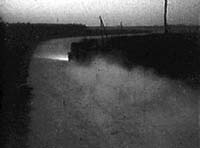 Figure 1 |
 Figure 2 |
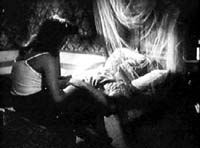 Figure 3 |
The purpose of this essay is to discuss different types of set-ups and
pay-offs - in the widest range of these terms. This discussion will lead to a
differentiation between the set-ups and pay-offs dominating, respectively,
classical and non-classical - or modernist - film. I do not suggest that the
two narrative modes are strictly separate, but that their differences are
useful points of access to the various kinds of interplay between film and
viewer that are driven by set-up and pay-off. The differentiation as well as
the stratification of set-ups and pay-offs will finally be used to argue that
modernist films are not at all as open as generally thought.
the empty gaps, the white spaces, the parts of the event that we are not given, are themselves of a concrete nature: stones that are missing form the building. It is the same with life: we don't know everything that happens to others.[2]This statement foreshadows one of my following points: the gaps and "white spaces" are not always left empty - at least not in the hands of an experienced viewer as Bazin, who interprets Rosselini's gaps as comments to the lacunas and uncertainties of life. That is: by withholding pay-off on one level, the text invites the viewer to seek other motivations, as here symbolic ones.
It should be clear by now, that I use the terms set-up, pay-off and gap in a more broad sense than is usually the case where the terms are confined to story and plot. The term story denotes the full-blown action itself, while the plot is the actual representation of the story.[4] A clear distinction between these two concepts is necessary, because they define two of the main categories of set-ups/pay-offs that will be dealt with in length. I do not limit the term gap to story/plot[5]; since this would more or less reduce the discussion to the classical cinema, where the story/plot dyad rules, and would - wrongly - classify modernist film as being without any pay-off and thus permanently open.
Dealing with gaps in the context of set-up and pay-off, the most important difference is between temporary and permanent gaps (the later actually being - at least at one level - set-ups without pay-offs). And it will be argued that permanent gaps at one level may be temporary at another.
Temporal manipulation by ellipsis is provided by skipping parts of the story (this omission may actually concern action that happened before the initial plot scene, as when the film starts with the investigation of a crime). If it is not going to be a permanent gap, and by this a set-up without pay-off, the skipped information - the pay-off - has to be recounted in words, shown in a flash-back (to make things simple I choose to limit chronology to the visual aspects of the film) or the consequences of the act have to provide cues about the omitted part of the story.
In Ossessione (Visconti) the ellipse withholds what happened in the car on the way back from town (Figure 1). The following scene gives a partial pay-off by showing the consequences: the husband died (Figure 2). More details - and the rest of the pay-off - is provided by recounting, e.g. as in Gino's confession to his mistress (Figure 3) .
 Figure 1 |
 Figure 2 |
 Figure 3 |
In the screen version of In Cold Blood (Brooks), the ellipsis creates the set-up about what actually happened that fatal night in the house of the Clutters. And the pay-off is delivered by the flash-back attributed to one of the murderers.
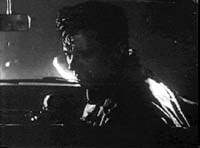 Figure 4 |
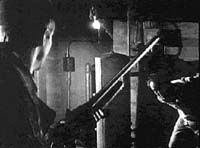 Figure 5 |
Another - more theoretical - possibility of setting-up by temporal manipulation is the reordering of chronology created by the flash-back; this implies breaking the "natural" linear order of the story. But since the flash-back as a rule - at least in classical narration - is tied to a diegetic person, it is unlikely that the person will begin to remember a past event in the middle of action important enough to create a set-up (unless the character is unable to realize the importance of the action).
The spatial manipulation is created by all sorts of cut-aways and framings withholding essential story information. That is: the gap between the set-up and pay-off is not caused by temporal means, but by the representation of space. The difference concerns the set-up, while the pay-offs are the same as those following temporal delay by ellipsis.
The Maltese Falcon (Huston) provides an excellent example of set-up by spatial means: the killing of Spade's partner, Archer. Here the set-up and the gap is created by keeping the killer off-screen. The pay-off is provided by recounting. To be strict this kind of manipulation is a matter of style but is here ranged among plot set-ups since it functions in similar ways as the temporal permutations
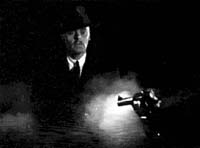 Figure 6 |
And since the plot does not necessarily follow the chronology of the "real" event - the story - it can create temporary gaps; which the story cannot due to the definition of the term. Again, this is too narrow a denotation of gaps and therefore also of set-up and pay-off. The story itself may create gaps, that is uncertainties about the future and outcome of events, which the chronological depiction may solve - which makes them temporary gaps - or may leave unsolved, that is if the story ends before the outcome - in which case the gaps are permanent. But by following the "natural" order of events, and avoiding ellipses that leave focused gaps, the set-up and pay-off on story level give the impression of minimal plot manipulation. This is helped to a large degree by the telic character progression. Even in the case of set-up and pay-off at story level, the plot still retards the pay-off, though in less obvious ways. The difference between plot and story set-up and pay-off is manifested in their different generic use. Films that deal with mysteries abound with set-up and pay-off created by the plot. Other genres - as melodrama, screwball-comedy and sit-com - lean on gapping and set-ups and pay-offs on the story level, since they are relatively communicative about past and present and focus on the suspense about future events.
A neo-classical film such as Pretty Woman (Marshall) is an excellent example. The omniscient and communicative cross-cutting between the different worlds of the prostitute Vivian (Julia Roberts, Figure 8) and the financier Edward (Richard Gere, Figure 7) creates a dense preliminary exposition, and is at the same time the basis for the main set-ups: How will they fit together when they meet? Is their affair going to last? The pay-offs are provided by the ongoing story and the "natural" development of cause-and-effect.
 Figure 7 |
 Figure 8 |
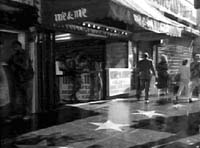 Figure 9 |
The permanent gap at story level in Fargo (Coen) on the other hand is more interesting in the context of set-up and pay-off. The film simply ends before the hidden money is found. This is a focused and permanent gap, since the money is the pretext for all the killings, and a part of the plot deals with one of the crooks burying it in the snow (where it obviously can't stay forever), not to mention that the money-bag is in the foreground of the exceptionally bare poster! Our urge for an answer makes us look for other explanations, other motivations and different kinds of pay-offs. And the apparently permanent gap is closed on another level - the thematic one.
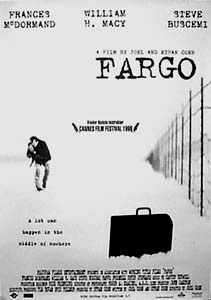 Figure 10 |
1) The presence, or absence, of material will be motivated realistically. This would be the case with a lot of the set-ups and pay-offs in Pretty Woman, where the withholding of the pay-offs until the end will be motivated by our experience with the chronology of cause and effect.2) A compositional motivation for presence or absence of material. That is when the spectator sees it as a necessity for an interesting unfolding of action. This is mainly done by set-up and pay-off on plot-level, as is the case with the withholding of the details about the crime in In Cold Blood.
3) A transtextual motivation, as when the generic knowledge about westerns makes an ending, where the main character just walks out in the blue, a satisfyingly closed one. This is the case in My Darling Clementine (Ford, Figure 11) and Shane (Stevens). In his work on endings Richard Neupert writes: "When Shane rides off into the distance, the story is in some ways left unresolved, yet this ending is a very typical generic closure device."[8]
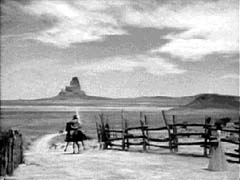 Figure 11 |
Now, there is no realistic or compositional reason for ending the story of Fargo before the fate of the money is determined, and this forces the viewer to look for other motivations. And the general narrative strategy of the film makes plausible other answers than those which are story/fabula-related. Thus the film not only possesses a very distinct story line - it is odd as well. The oddness does not only stem from the description of the unfamiliar environment of Minnesota and its population, but rather from the insistent digressions (e.g., the private life of the pregnant police officer, her meeting with the disturbed school friend, and similar details) that are not directly tied to or propelling the main story line. This may actually cue the viewer to apply a wider range of trans-textual motivations and to see the money-puzzle in a wider - thematic - context. The odd but harmonious family life of the police-officer and its contrast to the absurd killings, may in retrospect be the pay-off to the set-up "what happened to the money" which can be worded like "the money is insignificant in the light of all the killings". This hypothesis is confirmed by the earth-bound police officer's speech to the crook about the importance and worth of lives compared to money (her pregnancy underlines the value of life). Our urge for closure, answers and pay-off is thus fulfilled.
Of course, the viewer may apply themes to more classical films as well (as is done - quite obstinately - by Peter Wollen) but the pressure for seeking themes is of course less, since pay-off occurs at plot/story-level - in contrast to a lot of modernist films.
This is a strategy which is applicable to the films of Peter Greenaway, such as Drowning by Numbers - a film filled with permanent ambiguities, gaps and set-ups on story/plot level. A simple example is the beginning of the film where the wife drowns her husband while he is having a bath with his drunk mistress (Figure 12). Then the wife takes a pitchfork down from the wall while the mistress is slumbering in the tub (Figure 13). Cut to the garden where the wife throws the pitchfork on a bonfire (Figure 14). Now here we have a set-up at plot level: "Did the wife kill the mistress?" and the pay-off is provided a couple of minutes later, when the wife tells her daughter that she did (Figure 15). But she drowned the mistress too! Now why that? Why did she not do it the easy way with the fork? The answer to this set-up is only to be found at the parametric level: this would not fit the system, people are not supposed to be stabbed but to drown as the title suggests. There is no other logic to it. And the pitch-fork? The pitch-fork is there to fit the other part of the scheme - the presentation of numbers from 1 to 100 - since it creates number 4 in roman figures. This is a serial patterning of plot/story elements, but the films of Greenaway are ripe with parametric arrangement of style as well for example the playful camera movements and the tableaux of The Draughtsman's Contract.
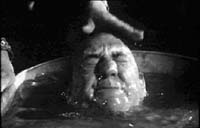 Figure 12 |
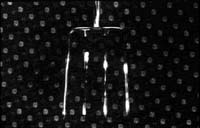 Figure 13 |
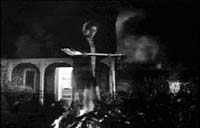 Figure 14 |
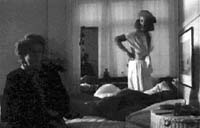 Figure 15 |
But sheer parametric reception will not suffice. To see the films of Peter Greenaway only as serial or structural artifacts is to neglect their pure audio-visual, that is aesthetic, attraction - which cannot be dealt with in terms of set-up and pay-off without stretching the terms excessively.
Even a combination of parametric and aesthetic attraction may still not be fully satisfactory. The film, after all, is a representative art, and in most cases representing humans, will force viewers to use the same procedures (as identification) as they use in daily life when they try to understand and foresee the behavior of their fellow humans.[10] This is of course strengthened by the fact that the bulk of the cinema (at least the classical cinema) deals with, and explicitly presents, cause/effect-relationships concerning humans - which has shaped our schemes and expectations about what films are supposed to be, and where the pay-offs are to be sought. That is why the unresolved puzzles and the opaque motives of the characters of The Draughtman's Contract may even frustrate viewers experienced with parametric narration.
Now are there no set-ups without pay-offs, permanent gaps and genuine open endings? Maybe, but I remain convinced that a viewer unable to apply any motivation to prominent parts of the material presented in a certain type of films will avoid this type in the long run.
Eventually one may ask if my broadening of the concepts set-up and pay-off does
not water them down? Perhaps, but at least it lifts a part of the veil of the
mystique and ambiguity clouding modernist film.
Bazin, André: What is cinema vol.2 University California Press, L.A.: 1971 (1953)Bordwell, David: Narration in the Fiction Film, Routledge, London 1990 (1985)
Burch, Noël: Theory of Film Practice, Princeton University Press, Princeton 1981 (1973)
Gorbman, Claudia: Unheard Melodies, Indiana University Press, Bloomington 1987
Grodal, Torben Kragh: Kognition, emotion and visual fiction, University of Copenhagen, København 1994
Jørholt, Eva: "A Frame is a Frame is a Frame" in SEKVENS 92, University of Copenhagen, Copenhagen 1992
Lemon, Lee T & Reis, Marion J. (ed.) Russian Formalist Criticism, University of Nebraska Press, Lincoln 1965
Pylyshyn, Zenon W.: Computation and Cognition, 2. ed., A Bradford Book, Massachusetts 1985
Sternberg, Meir: Expositional Modes & Temporal Ordering in Fiction, John Hopkins University Press, Baltimore 1978
Wollen, Peter: Signs and Meaning in the Cinema, Indiana University Press, Bloomington 1972
1 For the difference between diffuse/focused and flaunted/suppressed gaps see Bordwell p. 55.2 Bazin p. 66. 3 Pylyshyn pp. 12-15.
4 For a thorough discussion of the terms story/plot and fabula/syuzhet see Sternberg, chapter 1. 5 As Sternberg does.
6 Gorbman, p. 73.
7 Sternberg, p. 51.
8 Neuport, p. 29.
9Although Bordwell focuses on stylistic - that is audio-visual - examples of parametrical narration, he rightfully mentions that Noël Burch originally included plot and subject as sites for parametrical serialism (p. 278).
10 Grodal, Chapter 3.